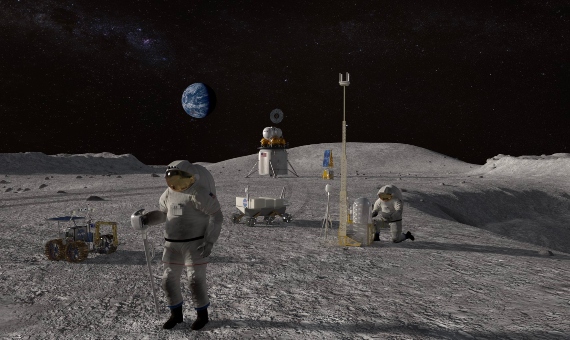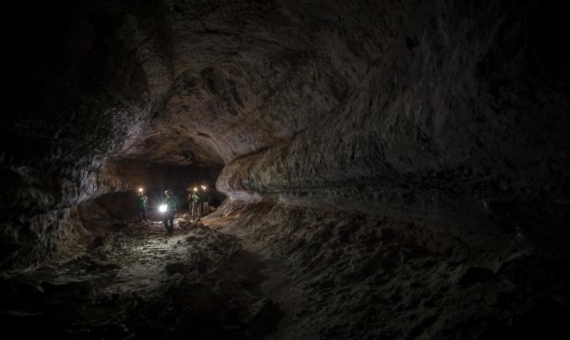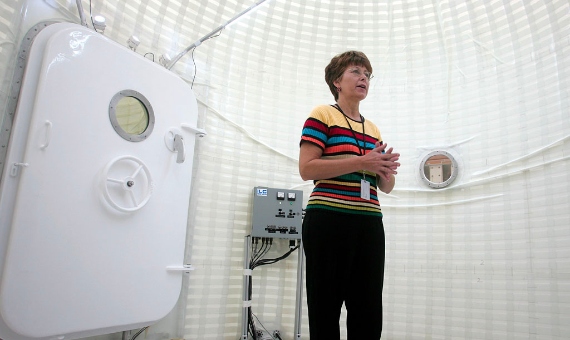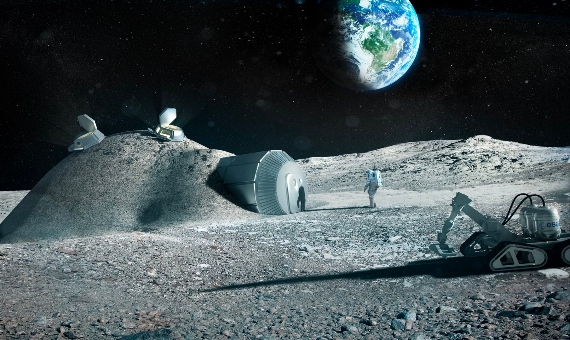When we imagine a future permanent human presence on the Moon or Mars we think of the great technical challenges that will have to be overcome, as we have all seen depicted in the movies. We wonder: What will they eat? How will they get water? Oxygen? Energy? How will they be able to stock enough medicine so that a curable disease on Earth will not be lethal there? And while these are all immense challenges, we may not be fully aware of the magnitude of the first and most fundamental task; one need only stop to look at the huge and complex set-up involved in any construction project. How will we build these off-Earth bases? With what materials? With what machines?

Constructing bases on the Moon or Mars is no longer just a fictional dream. In fact, so many projects have sprung up in recent years, especially related to the Moon, that one might think that the Earth’s satellite could become a busy place in the coming decades. NASA’s new Artemis programme, which aims to return to the Moon within this decade—the agency has acknowledged that the original goal of 2024 is unattainable—envisages placing at the lunar South Pole the Artemis Base Camp, which will include a foundational habitat and a habitable mobile platform: an enclosed, pressurised vehicle for multi-day expeditions outside the camp. The former director general of the European Space Agency (ESA), Johann-Dietrich Wörner, has been pushing the idea of building a Moon Village for years. Although his efforts have not resulted in a formal programme, the idea has been taken up by others to create the Moon Village Association.
The challenge of building with limited materials
In the wake of its successful Chang’e lunar missions, China also wants a lunar base; in June 2021, it jointly presented with Russia a plan to create an International Lunar Research Station (ILRS) by 2036, inviting other countries to join, although it is uncertain how recent global instability will affect these projects. The proposals have also been endorsed by numerous private entities. Tech moguls Jeff Bezos and Elon Musk, through their respective companies Blue Origin and SpaceX, have repeatedly expressed interest in signing up for lunar colonisation, as have other organisations such as the Open Lunar Foundation and the International MoonBase Alliance. And all of this is at the heart of Musk’s ambition to create a city on Mars by 2050.

Grandiose ambitions, but it is said that transporting a single brick to Mars would cost some $2 million. While it remains unclear where this calculation comes from, other estimates based on actual space missions suggest that the cost of launching a single kilo of payload simply to low Earth orbit can exceed $20,000. It thus seems certain that sending cement-laden dump trucks; large, prefabricated structures; cranes and bulldozers to another world is out of the question, even though science fiction movies show us large off-world stations with no shortage of shops or restaurants. For this reason, all research and proposals on off-world construction have the same inspiring principle as a mantra: In Situ Resource Utilisation (ISRU). In other words, limiting ourselves as much as possible to what is already there.
“We can’t establish a supply chain between Earth and Mars similar to what we have here, so we need to find ways to generate materials in an extremely resource-constrained environment,” Javier Fernandez, a bio-inspired materials scientist at the Singapore University of Technology and Design, tells OpenMind. This lack of resources can only be solved by human ingenuity. That is why this is a fertile field for multidisciplinary research that brings together the knowledge of materials chemists, geologists, geophysicists, engineers, architects, designers, planetary scientists, biologists, technologists and other experts in different fields. And while we are still far from having definitive solutions to overcome this first major stumbling block to the colonisation of other worlds, human ingenuity has already yielded some surprising ideas.
From Martian caves to inflatable buildings
The most immediate proposal is the most obvious: to take advantage of habitats that nature has already built for us. Mars’ volcanic past and the impact of meteorites on the Moon and the red planet have created Earth-like lava tubes, natural caves that could provide prêt-à-porter shelters. These caves have additional major advantages: their underground location would protect the occupants from cosmic and solar radiation—one of the greatest threats to life outside Earth—and from possible meteorites, as well as maintaining stable temperatures of around -20°C and providing easy access to subsurface mineral resources and possibly frozen water. What’s more, if life exists or once existed on Mars, evidence might be found in these caves.
Observations by lunar and Martian probes have detected the presence of these lava tubes, which due to the lower gravity on the Moon and Mars can reach gigantic sizes. A 2020 study estimated that the size of these tubes could accommodate small cities, with ceilings higher than the tallest skyscrapers on Earth. ESA has been training its astronauts in this type of terrain on the Canary island of Lanzarote through its CAVES and PANGAEA programmes, and is promoting projects aimed at the future exploration of lunar caves. However, this is no easy task: in addition to the difficulty of accessing and exploring such caves, study co-author Riccardo Pozzobon, a geoscientist at the University of Padua (Italy), told Live Science that the terrain would be very rugged and uneven, making the use inflatable habitats dangerous.

Inflatable modules, initially used in space stations, are one of the options often considered for creating future lunar or Martian bases. The work of Bigelow Aerospace, owned by hotelier Robert Bigelow, which in 2016 attached one of its modules to the International Space Station, deserves mention. The company developed a design for an inflatable lunar base, but laid off its entire workforce in the early weeks of the COVID-19 pandemic, and there is still no news on what its future will be. However, any design for this or any other type of surface habitat would require extra thick shielding to protect astronauts from dangerous radiation.
But the option that has attracted the most interest is undoubtedly the use of regolith (loose soil) from the Moon or Mars as a building material, according to the philosophy of ISRU. Since 1985, when researchers began to study the use of lunar substrate to make lunarcrete or mooncrete, a lunar concrete, countless proposals have been tested using artificial regolith that simulates lunar or Martian regolith, such as the so-called JSC (from NASA’s Johnson Space Center). Ignasi Casanova, a geochemist at the Universitat Politècnica de Catalunya and director of the Institute for Energy Techniques (INTE), explains to OpenMind that the problem with lunar regolith is that it is low in calcium oxide (CaO), an essential component of cement. In addition, for obvious reasons, the use of water must be avoided. “The manufacture of cement from lunar materials, although not impossible since some of them contain all the necessary chemical elements in considerable abundance, would require a large amount of energy,” says Casanova. Researchers are therefore exploring options such as replacing water with molten sulphur or compacting the material through sintering (compaction by pressure or heat) by laser or sunlight focused through large lenses, a process that, according to Casanova, “is still far from efficient.”
Printing moon bases with 3D technology
Ingenious researchers have come up with ideas for creating composite materials that can supplement the regolith with a binder or plasticiser of biological origin within the reach of colonists, avoiding the need for complicated processes and imported ingredients. One proposal is to use urea, a component abundant in urine, sweat and tears, or albumin, a protein from human blood. From the Singapore University of Technology and Design, Javier Fernandez is testing a Martian biolith that utilises chitin, the second most abundant biopolymer on Earth after cellulose, present in countless organisms including insects, which could be bred in a Mars habitat.
According to Fernández, chitin would be a by-product of the organic waste generated by humans, as it has no nutritional value for us, so it would be integrated into the ecological cycle of the Martian habitat in a sustainable, circular system with minimal waste. “To build solid objects, we mimicked the way crustacean shells incorporate minerals into chitin structures,” he says, noting that the biolith could be used not only to construct infrastructure, but also to manufacture components, spare parts and tools using 3D printing.

3D printing, or additive manufacturing, is the key technology that the bulk of the proposals are eyeing as a construction method for future off-world bases. The scaling up of the machinery has already allowed this system to be applied to construction on Earth. “ESA has been pioneering the use of 3D printing technologies to build a lunar base,” Laurent Pambaguian, a materials engineer at the European agency, tells OpenMind. ESA’s first project using 3D printing, in collaboration with the architectural firm Foster + Partners, consisted of a module to which an inflatable dome is attached and on which a thick layer of regolith is 3D printed. ESA is also involved in other projects in collaboration with various institutions. NASA has also explored the concept through its 3D-Printed Habitat Challenge competition.
“The challenges are many, including the means to collect and process the regolith, the share between what is available and what has to be brought from Earth, and how to eliminate the wastes,” says Pambaguian, to which he adds architecture, expansion, maintenance, energy, resources, and so on. The ideas do not stop there: buildings made of ice or even mushrooms have also been proposed. Human ingenuity knows no bounds, but there is still as long a journey ahead as from here to the Moon, or to Mars. “In my opinion, it is quite clear that we will have to learn as we go along,” concludes Casanova.
Javier Yanes
@yanes68
Comments on this publication